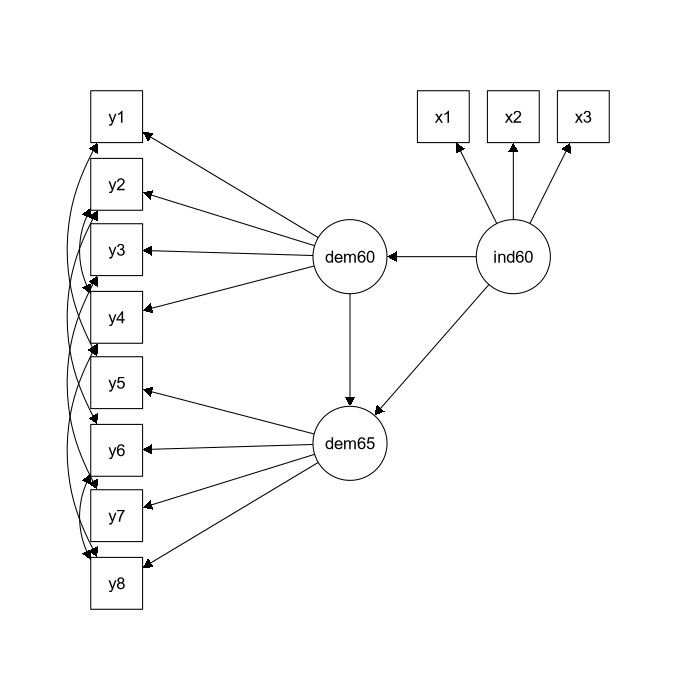Apply empirical bias reduced methods to fit a variety of latent variable models, including confirmatory factor analysis, structural equation modelling, and latent growth curve models.
Installation
You can install the development version of brlavaan from GitHub with:
# install.packages("pak")
pak::pak("haziqj/sem-bias")In brief
brlavaan provides explicit and implicit bias-reduction maximum likelihood estimation of latent variable models that are lavaan compatible. The main functions are
-
brsem()for structural equation models. -
brcfa()for confirmatory factor analysis models. -
brgrowth()for growth curve models. -
brlavaan()for a more general interface to fit any model supported by lavaan.
Note the convention of br prefix for all functions in this package. This is to distinguish between the bias-reduced methods and the standard maximum likelihood methods provided by lavaan.
[!WARNING]
Plugin penalties are not yet supported.
Example
Here’s the beloved classic example – Bollen (1989)’s political democracy example.

library(brlavaan)
#> Loading required package: lavaan
#> This is lavaan 0.6-19
#> lavaan is FREE software! Please report any bugs.
data("PoliticalDemocracy", package = "lavaan")
mod <- "
# latent variables
ind60 =~ x1 + x2 + x3
dem60 =~ y1 + y2 + y3 + y4
dem65 =~ y5 + y6 + y7 + y8
# regressions
dem60 ~ ind60
dem65 ~ ind60 + dem60
# residual covariances
y1 ~~ y5
y2 ~~ y4 + y6
y3 ~~ y7
y4 ~~ y8
y6 ~~ y8
"
# lavaan fit (ML)
fit_lav <- sem(model = mod, data = PoliticalDemocracy)
# Bias-reduced fit (by default, implicit method is performed)
fit_iRBM <- brsem(model = mod, data = PoliticalDemocracy)
summary(fit_iRBM)
#> brlavaan 0.1.1.9005 ended normally after 72 iterations
#>
#> Estimator ML
#> Bias reduction method IMPLICIT
#> Plugin penalty NONE
#> Optimization method NLMINB
#> Number of model parameters 31
#>
#> Number of observations 75
#>
#>
#> Parameter Estimates:
#>
#> Standard errors Standard
#> Information Observed
#> Observed information based on Hessian
#>
#> Latent Variables:
#> Estimate Std.Err z-value P(>|z|)
#> ind60 =~
#> x1 1.000
#> x2 2.176 0.139 15.607 0.000
#> x3 1.814 0.153 11.886 0.000
#> dem60 =~
#> y1 1.000
#> y2 1.254 0.185 6.791 0.000
#> y3 1.050 0.148 7.093 0.000
#> y4 1.254 0.150 8.374 0.000
#> dem65 =~
#> y5 1.000
#> y6 1.185 0.171 6.932 0.000
#> y7 1.268 0.159 7.970 0.000
#> y8 1.257 0.162 7.750 0.000
#>
#> Regressions:
#> Estimate Std.Err z-value P(>|z|)
#> dem60 ~
#> ind60 1.483 0.400 3.712 0.000
#> dem65 ~
#> ind60 0.570 0.236 2.417 0.016
#> dem60 0.832 0.098 8.510 0.000
#>
#> Covariances:
#> Estimate Std.Err z-value P(>|z|)
#> .y1 ~~
#> .y5 0.646 0.382 1.693 0.090
#> .y2 ~~
#> .y4 1.292 0.707 1.828 0.068
#> .y6 2.140 0.732 2.923 0.003
#> .y3 ~~
#> .y7 0.816 0.640 1.275 0.202
#> .y4 ~~
#> .y8 0.407 0.476 0.856 0.392
#> .y6 ~~
#> .y8 1.312 0.572 2.294 0.022
#>
#> Variances:
#> Estimate Std.Err z-value P(>|z|)
#> .x1 0.083 0.020 4.071 0.000
#> .x2 0.122 0.072 1.699 0.089
#> .x3 0.472 0.091 5.169 0.000
#> .y1 1.896 0.481 3.943 0.000
#> .y2 7.362 1.353 5.443 0.000
#> .y3 5.161 1.004 5.143 0.000
#> .y4 3.198 0.779 4.107 0.000
#> .y5 2.406 0.513 4.694 0.000
#> .y6 4.919 0.896 5.492 0.000
#> .y7 3.474 0.748 4.642 0.000
#> .y8 3.271 0.719 4.547 0.000
#> ind60 0.447 0.086 5.197 0.000
#> .dem60 4.019 0.958 4.197 0.000
#> .dem65 0.203 0.231 0.880 0.379
# Should be different
tinytest::expect_equal(coef(fit_iRBM), coef(fit_lav))
#> ----- FAILED[data]: <-->
#> call| tinytest::expect_equal(coef(fit_iRBM), coef(fit_lav))
#> diff| Mean relative difference: 0.01134476By default, the implicit reduced bias ML estimator is used. To switch to the explicit RBM, or to add a plugin penalty term, specify these as a list to the estimator.args argument.
# for explicit RBM
fit <- brsem(model = mod, data = PoliticalDemocracy,
estimator.args = list(rbm = "explicit"))
# for implicit RBM with plugin penalty
fit <- brsem(model = mod, data = PoliticalDemocracy,
estimator.args = list(rbm = "implicit",
plugin_penalty = brlavaan:::pen_huber))To switch off the bias reduction, set rbm = "none":